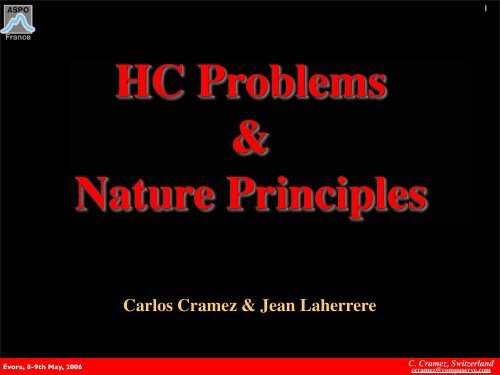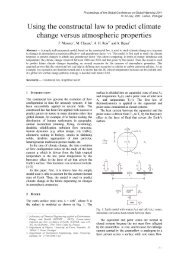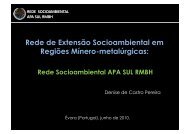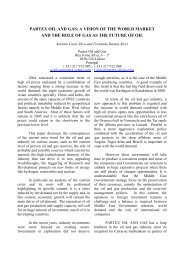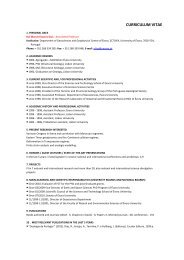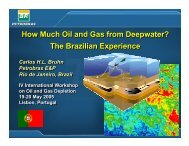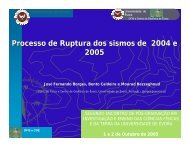C. Cramez, Switzerland
C. Cramez, Switzerland
C. Cramez, Switzerland
- No tags were found...
Create successful ePaper yourself
Turn your PDF publications into a flip-book with our unique Google optimized e-Paper software.
1HC Problems&Nature PrinciplesCarlos <strong>Cramez</strong> & Jean LaherrereÉvora, 8-9th May, 2006C. <strong>Cramez</strong>, <strong>Switzerland</strong>ccramez@compuserve.com
ForewordThe understanding of:- Energy problems,- Peak oil production and- HC remaining reservesis based on Nature Principles, which allow the interpretationof HC Data and so advance several conjectures.Évora, 8-9th May, 20062C. <strong>Cramez</strong>, <strong>Switzerland</strong>ccramez@compuserve.com
Part IHC ProblemsReviewÉvora, 8-9th May, 20063C. <strong>Cramez</strong>, <strong>Switzerland</strong>ccramez@compuserve.com
HC Problems1) At the end 2005, the amount of liquid hydrocarbonsproduced since 1859 is (±1-2%)1 000 Gb (1 000 billion barrels).2) Likely, the remaining reserves are:- 1 000 Gb of oil,- 500 Gb of extra-heavy,- 250 Gb of natural gas liquids,- 250 Gb of refining technology+synthetic oils from coal & biomass.Évora, 8-9th May, 20064C. <strong>Cramez</strong>, <strong>Switzerland</strong>ccramez@compuserve.com
Peak Oil DepletionTrend lines, scenarios 2005Our prediction (in purple) is slightly optimistic than ASPO 2005 (in yellow), but largely pessimistic whencompared with the predictions of conventional petroleum-related organisations, such as IHS, EIA, PB,Total, OPEC, etc.5C. <strong>Cramez</strong>, <strong>Switzerland</strong>ccramez@compuserve.comÉvora, 8-9th May, 2006
HC Problems3) In early 2005, estimated global oil demandwas forecast to reach 86 Mb/d (millions barrelsa day) or more by the end of the year.Demand increases had exceeded forecastseach year from 2002 to 2004.4) Sooner or later, the worldwide use of oilmust peak, because oil, like the other twofossil fuels, coal and natural gas, is nonrenewable.Évora, 8-9th May, 20066C. <strong>Cramez</strong>, <strong>Switzerland</strong>ccramez@compuserve.com
Oil Production Forecast(Salvador, A. vs Laherrere, J.)A. Salvador’s recent paper is quite optimistic in relation to our prediction. However, we believe that ourdata is technical data and so less influenced by politics whether of Governments or Oil companies. Noticethat our all liquids and oil curves are made for a 3 Tb (3.000 Gb) of ultime reserves.Évora, 8-9th May, 20067C. <strong>Cramez</strong>, <strong>Switzerland</strong>ccramez@compuserve.com
HC Problems5) The main reason that many oil experts havescoffed at claims that the peak oil mightoccur sooner than later is their belief in thesuperabundance of Saudi Arabia’s oil resources.6) Development is now underway on a number of giant oil fields around the world(Kasaghstan, Gulf of Mexico, West Africa),but none of these projects is expected toproduce in excess of 200-250 kb/d.Évora, 8-9th May, 20068C. <strong>Cramez</strong>, <strong>Switzerland</strong>ccramez@compuserve.com
HC Problems7) The volume of water produced from theworld’s oil fields is now estimated to exceed200 Mb/d, nearly 3x the volume of the oil.Oil wells in US produce more than 7 bl ofwater for each barrel of oil. (M. Simmons, 2005)8) The annual cost to US producers for disposingof this produced water is USA $5-10 G.Worldwide, the costto handle superfluouswater is estimated to be around USA $40 G(billions) (M. Simmons, 2005)Évora, 8-9th May, 20069C. <strong>Cramez</strong>, <strong>Switzerland</strong>ccramez@compuserve.com
In addition,please don’t forget what they say:(Y. Cochet, 2005)A barrel of oil has a potential energy equivalentto 35 000 hours of human work.The production price of human mechanicwork is USA $200 the barrel (taking intoaccount European gasoline taxation).Using humans to do the same work (USA $20/hour), the price will be roughly $200 000, i.e.1 000 x more expensive than oil + engine.Évora, 8-9th May, 200610C. <strong>Cramez</strong>, <strong>Switzerland</strong>ccramez@compuserve.com
HC ProblemsThis plot indicates the price of the oil (number of working hours need to buy a barrel of oil) drops since1950 till the 1972-1973. Then, it jumped to reach a maximum during the 80s. Then abruptly, the pricecame down till 1998 to start rising again till today.12C. <strong>Cramez</strong>, <strong>Switzerland</strong>ccramez@compuserve.comÉvora, 8-9th May, 2006
(M. Simmons, 2005)The most urgent energy question for theworld, as oil consumption fast approaches85 Mb/d, involve the sustainability of SaudiArabia’s oil production.Saudi Arabia clearly seems to be nearingor is at its peak output and cannot materiallygrow its oil production. In all probability,output peaked in 1981 at an unsustainablelevel of about 10 Mb /d.Évora, 8-9th May, 200613C. <strong>Cramez</strong>, <strong>Switzerland</strong>ccramez@compuserve.com
Middle East Oil FieldsAccording to Campbell (2002), the total Middle East reserves are: (i) Discovered Reserves around 758 Gbl,(ii) to Yet to Find 47 Gbl and (iii) Ultimate 805 Gbl. Such values represent respectively 43%, 33% and 42%of the total World Reserves. Saudi Arabia represents roughly 40% of Middle East reserves.Évora, 8-9th May, 200614C. <strong>Cramez</strong>, <strong>Switzerland</strong>ccramez@compuserve.com
Saudi ArabiaOil Fields DynastySaudi Arabia represents roughly 40% ofMiddle East reserves. They are mainlyassociated with four major fields:(i) the “King” Ghawar,(ii) the “Queen” Safaniya,(iii) the “Dowager Queen” Abqaiq and(iv) the “Prince” Berri.In the majority of hydrocarbon basins a hierarchy of oil fields is often recognized: (i) a King, (ii) a Queenor perhaps two or three, (iii) a handfull of Earls or Lords (5 or 10) and (iv) a larger number of Commonersor Peasants. Ghawar, King of all Kings, discovered in 1948 and onstream in 1952, is the largest oil field inthe world. It has now produced over 55 billion barrels. Its oil accounted for 55 to 65% of Saudi Arabia’stotal production.15C. <strong>Cramez</strong>, <strong>Switzerland</strong>ccramez@compuserve.comÉvora, 8-9th May, 2006
Ignoring the risks posedby the oil peak of SaudiArabia any longer isfolly.I don’t seeanythingÉvora, 8-9th May, 200616C. <strong>Cramez</strong>, <strong>Switzerland</strong>ccramez@compuserve.com
Applying the Basic Principles ruling the Nature on theavailable data base:HC Problems- OPEC,- OGJ,- Petroconsultants,-IHS,- BP review,- World Oil,- USDOE/EIA,the following conjectures on Exploration / Productioncan be postulated:Évora, 8-9th May, 200617C. <strong>Cramez</strong>, <strong>Switzerland</strong>ccramez@compuserve.com
Conjectures.Évora, 8-9th May, 200618C. <strong>Cramez</strong>, <strong>Switzerland</strong>ccramez@compuserve.com
ConjecturesConjecture 5:Cheap Oil will peak soon inNorth Sea and in Non-OPECcountries. For the world, it peaksprobably this year.Évora, 8-9th May, 200619C. <strong>Cramez</strong>, <strong>Switzerland</strong>ccramez@compuserve.com
HC ProblemsThe oil production in the last 20 yearswas estimated at roughly at 70 Mb/d:- 40 Mb/d from giant fields,- 7 Mb/d from small fields,- 12 Mb/d from new developed fields,- 10 Mb/d from improved fields and- 3 Mb/d from new discoveries.Évora, 8-9th May, 200620C. <strong>Cramez</strong>, <strong>Switzerland</strong>ccramez@compuserve.com
As illustrated , around 100 fields produce 50% of the reserves consumed per day. More than 95 percent ofthe fields produce less than 10.000 barrel per day and less of 1% produce more than 500.000 barrels perday. In other words, as said previously, in the world there are there 14 Kings (Ghawar being the King ofKings), 40 Queens, 61 Earls or Lords and quite a larger number (> 4.000) of Commoners or Peasants.Évora, 8-9th May, 200621C. <strong>Cramez</strong>, <strong>Switzerland</strong>ccramez@compuserve.com
Part IINature PrinciplesReviewÉvora, 8-9th May, 200623C. <strong>Cramez</strong>, <strong>Switzerland</strong>ccramez@compuserve.com
Nature is ruled by some24basic PrinciplesInequalitySelf-SimilarityNatureFractal DistributionCyclicityFinitenessGravitationLifeDeterminism & ProbabilismÉvora, 8-9th May, 2006SymmetryC. <strong>Cramez</strong>, <strong>Switzerland</strong>ccramez@compuserve.com
InequalityEquality may exist atthe starting line, but atthe end there is usuallyonly a winner.Évora, 8-9th May, 200625C. <strong>Cramez</strong>, <strong>Switzerland</strong>ccramez@compuserve.com
Inequality is the rule in NatureÉvora, 8-9th May, 200626C. <strong>Cramez</strong>, <strong>Switzerland</strong>ccramez@compuserve.com
Inequality27On this subject, it is quite interesting to notice that US has 5% of the world population, spends 25% of theenergy in world, has 40% of the autos in the world, represents 60% of the world commerce and has 70% ofthe lawyers in the world.Évora, 8-9th May, 2006C. <strong>Cramez</strong>, <strong>Switzerland</strong>ccramez@compuserve.com
InequalityThe worldwide oil field hierarchy is easily recognised on this plot. Ghawar, the King of kings, with five (5)others kings and 15 queens represent 90% of world reserves outside USA and Canada. The Earls andLords are around 90 and they contribute to 9% of the reserves. The last 1% comes from more than 4000Commoners and Peasants. In other way, inequality is a characteristic of oil and gas fields.Évora, 8-9th May, 200628C. <strong>Cramez</strong>, <strong>Switzerland</strong>ccramez@compuserve.com
Self-similarityNature is characterizedby self-similarity. Naturalobjects have a fractalgeometry.Évora, 8-9th May, 200629C. <strong>Cramez</strong>, <strong>Switzerland</strong>ccramez@compuserve.com
A part is similar to the wholeSimulation of crystal growth. The fine structure of the “crystal” is self-similar. A part is similar to thewhole. However, it is relevant here to point out that the sum of the part is not equal to the whole. The wholeis more than the sum of the parts and its characteristics cannot be approached by the study of the parts inisolation.30C. <strong>Cramez</strong>, <strong>Switzerland</strong>ccramez@compuserve.comÉvora, 8-9th May, 2006
A natural object, or geometric figure, is fractal when:31Its parts have the same shape (structure), in spite of their scaleor deformation.Its shape is either irregular, interrupted or fragmented independentlythe scale of observation.It contains distinctive elements, which scales are very variedand covering a very wide range.500 m 1000 mÉvora, 8-9th May, 2006C. <strong>Cramez</strong>, <strong>Switzerland</strong>ccramez@compuserve.com
32Self-similarityOn this line of Gulf of Mexico, self-similarity is paramount in turbidite depositional systems. Indeed, inslope fans, channel-levees complexes (whole) are composed by a multitude of parts with same shape andstructure in spite of their small scales.Évora, 8-9th May, 2006C. <strong>Cramez</strong>, <strong>Switzerland</strong>ccramez@compuserve.com
Geoscientists know a scale is necessary to interpretan outcrop or seismic line.Without scales, orientation and location (outside of the geological setting) and the geological interpretationof a seismic line is meaningless, because self-similarity. Indeed, a slope delta is similar to a continental slopeand to any offlap.Self-similarity = FractalÉvora, 8-9th May, 200633C. <strong>Cramez</strong>, <strong>Switzerland</strong>ccramez@compuserve.com
Geology is Scale Dependent.Interpretation requires a scale.Self-similarity obliges.Deltaic slopeorContinental slopeUnconformity ?As Geology is scale dependent, geological seismic interpretations cannot be performed without knowing thescales, as well as the global and regional settings. On this line, interpreters will be enable to interpret thedepositional inclined reflector . The reader is supposed to make a guess: shelf or slope downlaps?Évora, 8-9th May, 200634C. <strong>Cramez</strong>, <strong>Switzerland</strong>ccramez@compuserve.com
Geology is Scale Dependent.Interpretation requires a scaleSelf-similarity obligesThis line is a georadar line shot in onshore France (Pin Sec). The vertical scale is in nanoseconds. Theinterpretation was based in a calibration well, in which georadar velocities range from 0,08 to 0,13 ns. Thedepositional inclined reflectors are not associated to a deltaic or continental slope, but small obliquebedding planes (probably strandlines).35C. <strong>Cramez</strong>, <strong>Switzerland</strong>ccramez@compuserve.comÉvora, 8-9th May, 2006
Fractal Distribution(Parabolic)Natural objects, or naturalevents, when listed in decreasingsize and plotted on a log-logformat with size against rankshow a parabolic fractaldistribution.Évora, 8-9th May, 200636C. <strong>Cramez</strong>, <strong>Switzerland</strong>ccramez@compuserve.com
Fractal Distribution- Galactic intensity,- Town sizes,- Reserves,- Field sizes,- HC accumulations within a given PS, etc.have a fractal parabolic distribution.Évora, 8-9th May, 200637C. <strong>Cramez</strong>, <strong>Switzerland</strong>ccramez@compuserve.com
38Galactic IntensityIn this infrared view of the entire sky, blue represents close and bright stars in the Milky Way. It alsoreveals the distribution of the galaxies beyond the Milky Way, presenting galaxy clusters and superclustersas filaments throughout the image. The galactic intensity (flux radio, luminosity) when listed indecreasing size and plotted on a log-log format, with size against rank, shows a parabolic fractaldistribution, as illustrated next.Évora, 8-9th May, 2006C. <strong>Cramez</strong>, <strong>Switzerland</strong>ccramez@compuserve.com
39Fractal DistributionIndeed, as illustrated above, he galactic intensity (flux radio, luminosity) when listed in decreasing size(decreasing luminosity) and plotted on a log-log format, with size against rank, shows a fractaldistribution. However, as illustrated next, several fractal parabolic curves can be considered.Évora, 8-9th May, 2006C. <strong>Cramez</strong>, <strong>Switzerland</strong>ccramez@compuserve.com
Fractal DistributionUSA urban agglomeration were listed in decreasing size and plotted in a log-log display against rank. Thedata shows a fractal distribution. Several extrapolation are possible: (i) Mandelbrot-Zipf, (ii) Fractalparabolic and (iii) Stretched exponential. Perfect self-similarity is a power law or linear fractal in log-logdisplay (size/rank). Imperfect similarity is a curved display. The simplest seems to be the parabolic fractal.Évora, 8-9th May, 200640C. <strong>Cramez</strong>, <strong>Switzerland</strong>ccramez@compuserve.com
Fractal ParabolicIt is evident that in this particular exemple the best fit is parabolic fractal, at least for small and mediumranks. Similarly, in basinal turbidite depositional systems, the plot of thickness of the lobes against rank,on a log-log format, shows a parabolic fractal distribution.Évora, 8-9th May, 200641C. <strong>Cramez</strong>, <strong>Switzerland</strong>ccramez@compuserve.com
Fractal Parabolic42undiscoveredaccumulations(in the ground)Plotting in a log-log display, reserves versus rank shows also a fractal distribution. The fractal paraboliccurve allows geoscientists to predict, roughly, undiscovered accumulations. Such a distribution, which alsoobserved in single petroleum basins allows to determine the degree of maturation of exploration.Évora, 8-9th May, 2006C. <strong>Cramez</strong>, <strong>Switzerland</strong>ccramez@compuserve.com
Fractal Parabolic43The size plotted versus rank shows a fractal distribution (in green) that fits, not very badly, with the fractalparabolic curve distribution (in pink). The cumulative reserves curve (in blue) strongly suggest ultimatereserves around 2-3 Gb. Remind, that, as said previously, more than 1 Gb have already been produced, soprobably, we have already spent half, or very near, of the world reserves.Évora, 8-9th May, 2006C. <strong>Cramez</strong>, <strong>Switzerland</strong>ccramez@compuserve.com
CyclicityAll natural eventscan be depictedby one or several cycles.Évora, 8-9th May, 200644C. <strong>Cramez</strong>, <strong>Switzerland</strong>ccramez@compuserve.com
CyclicityLive births, deaths, natural increase, infant deaths, foetal deaths, marriages, divorces, that is to say,natural events are cyclic. In Japan annual events, an anomaly must be taken into account, in 1968/1970,the Hinouema or the malefic year.Évora, 8-9th May, 200645C. <strong>Cramez</strong>, <strong>Switzerland</strong>ccramez@compuserve.com
CyclicityNothing is eternalWhat is born will dieWhat goes up will come downSun, earth, mankind, civilisation, etc.will die.Évora, 8-9th May, 200646C. <strong>Cramez</strong>, <strong>Switzerland</strong>ccramez@compuserve.com
CyclicityDepositional Systems are CyclicSince long time, geoscientits notice the cyclicity of deposition systems and tried to explain it. Admittedly,after Benoit de Maillet and Lavoisier, the majority of them assume that Eustasy, that is to say, sea levelvariations, is the mainly source of the cyclicity of the depositional systems.Évora, 8-9th May, 200647C. <strong>Cramez</strong>, <strong>Switzerland</strong>ccramez@compuserve.com
Cyclicity48The Earth’s history, at least since Phanerozoic (600 Ma), can be depicted as cyclic. After the gathering ofthe Proto-Pangea supercontinent, it broke in several continents, which dispersed to a maximum, by seafloor spreading, before gathered, again, to form the Pangea. Then, the Pangea broke up in severalcontinents, which after dispersion are gathering to form a new supercontinent. These major geologicalcycles, recognized by Wilson Tuzco, are known as Wilson’s cycles.Évora, 8-9th May, 2006C. <strong>Cramez</strong>, <strong>Switzerland</strong>ccramez@compuserve.com
CyclicityMajor Geologic Events are CyclicThe Plate Tectonics paradigm, which is a cyclic theory, explains quite well the correlation between majorgeologic events, which are interlinked and interconneted. Indeed, they cannot be understood in isolation. Asytemic, or global approach, is required to understand the whole, which is much more than the sum of theparts. Detail studies can be fascinating, but, unfortunately, we learn from generalities.Évora, 8-9th May, 200649C. <strong>Cramez</strong>, <strong>Switzerland</strong>ccramez@compuserve.com
Cyclicity50The number of wells drilled in petroleum exploration, as all natural events, seems to be cyclic, as suggestedby this plot (nº of wells drilled per year). Such a cyclicity can be due to demand problems, new plays(turbidite depositional systems), new technology (deepwater drilling or seismic acquisition), etc.Évora, 8-9th May, 2006C. <strong>Cramez</strong>, <strong>Switzerland</strong>ccramez@compuserve.com
Cyclicity51The stratigraphic distribution of the source rocks, as the majority of geological features, shows a sharpcyclicity, which is explained by Plate Tectonics. The marine source sources are associated with the 1storder eustatic highs, that is to say, Jurassic-Cretaceous and Cambrian-Silurian transgressions. Notice thatHercynian orogeny destroy a huge amount of hydrocarbons which are not taken into account in this plot.Évora, 8-9th May, 2006C. <strong>Cramez</strong>, <strong>Switzerland</strong>ccramez@compuserve.com
FinitenessInfinite, as perpetualgrowth, does not exist.Earth, as well Universe,is limited.Évora, 8-9th May, 200652C. <strong>Cramez</strong>, <strong>Switzerland</strong>ccramez@compuserve.com
FinitenessThe rate of decline varies according to the volumes each field was producing when it peaked. Hydrocarbonoutput begins to decline as encroaching water and gas simply crowd out the oil (M. Simmons, 2005).Évora, 8-9th May, 200654C. <strong>Cramez</strong>, <strong>Switzerland</strong>ccramez@compuserve.com
Finiteness55Three spaces are possible in relativity:1) No curvature,2) Positive curvature,3) Negative curvature.Évora, 8-9th May, 2006The more likely, it is the one with a positive curvature (2).C. <strong>Cramez</strong>, <strong>Switzerland</strong>ccramez@compuserve.com
56What means finitenessin mathematical termsSuppose this natural distribution:2, 4, 6, ?, ?, ?rank: 1,2,3,..........n-2, n-1, nvalue: 2, 4, 6,........N-2, N-1, NHow many solutions do you propose?Évora, 8-9th May, 2006C. <strong>Cramez</strong>, <strong>Switzerland</strong>ccramez@compuserve.com
There is a large number of solution:There are 14 solutions (1st degree)2, 4, 6, 8, 10, 12, 14, 16 N=2n or N=(N-1)+22, 4, 6, 10, 16, 26, 42, 68 N=(N-1)+(N-2)2, 4, 6, 8, 10, 12, 14, 16 N=2(N-1)-(N-2)2, 4, 6, 6, 0, -18, -54, -108 N=3(N-1)-3(N-2)2, 4, 6, 4, -14, -76, -234, -556 N=4(N-1)- 9(N-2)and so onOccam’s razor suggests the simplest,i.e. minimum complexity2, 4, 6, 8, 10, 12, 14, 16 N=2nButÉvora, 8-9th May, 200657C. <strong>Cramez</strong>, <strong>Switzerland</strong>ccramez@compuserve.com
58In Nature, too simple is often falseAll that is simple is false and all that is complex is useless.(Paul Valéry)Continuous growthisimpossible in NatureIndeed, the series 2, 4, 6, ?, ?, ?, has a beginning andgrows, in life, it should peak and decline, negative valuesdo not exist.Évora, 8-9th May, 2006C. <strong>Cramez</strong>, <strong>Switzerland</strong>ccramez@compuserve.com
Continuous Growth is Impossible in NatureNo negative values in NatureThe simplest natural answer is 2,4,6,6.0 (N=3(N-1)-3 (N-2). Notice that modelling is just an approximation(there are no negative values in Nature). It should be simple and convenient. Many models can fit the data,but some give unrealistic extrapolations. Try different models and check the extrapolations. Select themodels that fit other natural distributions.59C. <strong>Cramez</strong>, <strong>Switzerland</strong>ccramez@compuserve.comÉvora, 8-9th May, 2006
The simplest natural answer is2, 4, 6, 6, 0 N=3(N-1)- 3(N-2)Therefore, the same happens with oil production,remaining reserves, oil discoveries, etc.Évora, 8-9th May, 200660C. <strong>Cramez</strong>, <strong>Switzerland</strong>ccramez@compuserve.com
Finiteness61Assuming that when oil production peaks half of the reserves have already been produced, one can saidthat cheap oil is finished. Probably, very soon, if not already, we will be in left part of the purple curve. Thediscrepancies between the curves are artificial; lot of them are based in political and not technical data.Évora, 8-9th May, 2006C. <strong>Cramez</strong>, <strong>Switzerland</strong>ccramez@compuserve.com
Finiteness62Proven + ProbableProvenThose acquainted with oil business know reserves can changes according economical and political interests.On this plot, the green curve, made up with technical data (proven + probable, corrected), stronglyindicated that since 1980, the oil produced is not replaced by discoveries. This obvious fact does not interestto several oil companies and government, which assume an eternal growth (proven) (”nihil aliud opus est”).USA companies follow the Securities and Exchange Commission which, contrariwise to the all othercountries, publishes only proved reserves (financial data) and not probable reserves (technical data).C. <strong>Cramez</strong>, <strong>Switzerland</strong>ccramez@compuserve.comÉvora, 8-9th May, 2006
GravitationEverything is curved.Linearity exists only locallyTo picture the solar system think ofspace-time as a rubber sheet withthe Sun as a heavy ball and planetsas a marble place on it. This isEinstein’s model of the way mattercurves space-time and helps visualisethe force of gravity betweenmasses.Évora, 8-9th May, 200663C. <strong>Cramez</strong>, <strong>Switzerland</strong>ccramez@compuserve.com
Gravitation64Gravity AnomaliesThe geoid is the most graphical representationof the Earth gravity field. Thelargest positive geoid heights are associatedwith subduction zones and hotspots andhave no simple relationship to other highregions such as continents and ridges.Subsequently, as sea level is not uniform, aglobal rise of 10 meters, induced forinstance by a deglaciation, does not givethe same relative consequences all aroundthe Earth. Probably, in sequence stratigraphy,the majority of unconformitieshave a regional extend but not global.Earth’s MorphologyÉvora, 8-9th May, 2006C. <strong>Cramez</strong>, <strong>Switzerland</strong>ccramez@compuserve.com
All clastic sediments are deposit by gravityBraided-streamsEolian depositsYes, I seePyroclastis depositsSnow depositsÉvora, 8-9th May, 200665C. <strong>Cramez</strong>, <strong>Switzerland</strong>ccramez@compuserve.com
Marine Clastic Deposition(after P. Vail, 1977)Eustasy is supposed to be the major reason of the cyclicity of the sediments. However, sediments must betransported before being deposited, so gravity plays also an important role. In this model, the verticalexaggeration is almost 100 x. Each black line corresponds to a chronostratigraphic line. Their spacing is100k years. Terrigeneous influx is constant (area between two consecutive chronostratigraphic lines is thesame). The red lines correspond to unconformities (erosional surfaces). The green dots underline thesuccessive positions of the shelf breaks.66C. <strong>Cramez</strong>, <strong>Switzerland</strong>ccramez@compuserve.comÉvora, 8-9th May, 2006
LifeLife is everywhereÉvora, 8-9th May, 200667C. <strong>Cramez</strong>, <strong>Switzerland</strong>ccramez@compuserve.com
LifeLake MichiganThe bright color that appears in late summer in Lake Michigan is caused by the calcium carbonate in thewater and not by life. Lake Michigan always has a lot a calcium carbonate because the floor of the lake islimestone. During most of the year the calcium carbonate remains dissolved in the cold water, but at theend of summer the lake warms up, lowering the solubility of calcium.Évora, 8-9th May, 200668C. <strong>Cramez</strong>, <strong>Switzerland</strong>ccramez@compuserve.com
Life & Gravity69control sedimentationVail’s model for clasticsGravity controlledVail’s model for carbonateLife controlledThe carbonate depositional model of Exxon is illustrated on right was built using Marco Polo software. Theparameters Eustasy and Subsidence are exactly the same that those used in the sand-shale model, also, therelative sea level curve is the same in both models. The only difference is the sedimentary input. In thesand-shale model, the sediments are transported from the continent toward the sea and the terrigeneousinput is conventionally taken as constant, in the carbonate model, the algal and reef production aremaximal (5-7 cm/ky) near surface at 2-3 meters water depth.C. <strong>Cramez</strong>, <strong>Switzerland</strong>ccramez@compuserve.comÉvora, 8-9th May, 2006
70Carbonate BuildupsCarbonate buildups, as those illustrated on this line from off as other organic rocks obey to the three basicprinciples controlling life that we will review next.Évora, 8-9th May, 2006C. <strong>Cramez</strong>, <strong>Switzerland</strong>ccramez@compuserve.com
LifeLife is controlledby three majorlaws.Which laws?Évora, 8-9th May, 200671C. <strong>Cramez</strong>, <strong>Switzerland</strong>ccramez@compuserve.com
LifeLife is controlled by three major lawsa) Fermat-Maupertius’s lawor Principle of minimum action.b) Snell’s lawor Principle of minimum time.c) Fibonacci’s lawor Principle of maximum room.Évora, 8-9th May, 200672C. <strong>Cramez</strong>, <strong>Switzerland</strong>ccramez@compuserve.com
Snell’s law(Principle of Minimum Time)During refraction of light, the ratio of the sines of the angles of incidence (i1)and refraction (i2) is a constant equal to the refractive index of the medium.The reflection case illustrates a point aboutFermat's principle: the minimum time mayactually be a local rather than a globalminimum. Trajectories allowed by Fermat'sprinciple don't strictly have to be minimumtime trajectories. They can also bemaximum time trajectories.incidentWateAirefractedÉvora, 8-9th May, 200674C. <strong>Cramez</strong>, <strong>Switzerland</strong>ccramez@compuserve.com
Fibonacci’s law(Principle of Maximum Room)In a Fibonacci sequence each term (after the first two) is the sum of thepreceding two: 1, 1, 2, 3, 5, 8, 13, 21, 34, 55...This simple pattern can determine the shapeof a seashell, pine-cones or the sprouting ofleaves from the stem of any plant. Thisconnection to the organic world is reflected inthe surface pattern, which is achieved throughthe process of smoke firing.Fibonacci sequence has many other interestingmathematical properties. For example, theratio od successive terms (larger to smaller;1/1, 2/1, 3/2, 5/3, 8/5, 13/8....) approaches thenumber 1.618 (phi). This ratio is known as theGolden Ratio.Each floret is peaked and is an identical but smaller versionof the whole thing and this makes the spirals easy to see.Évora, 8-9th May, 200675C. <strong>Cramez</strong>, <strong>Switzerland</strong>ccramez@compuserve.com
Fibonacci’s law76(Principle of Maximum Room)“The eye of God”T. Ferris, 1992The architecture of Nautillus’ shell can be compared with a series of nested Golden Rectangles obtained whenyou snip off squares from a Golden Rectangle. If we connect the successive points where these whirlingsquares divide the sides in Golden Rations, we obtain a logarithmic spiral that coils inward toward the pole(the point given by the intersection of the diagonals, which was called fancifully “The eye of God”).Évora, 8-9th May, 2006C. <strong>Cramez</strong>, <strong>Switzerland</strong>ccramez@compuserve.com
Determinism & ProbabilismNatural evolution is asuccession of stagesdescribed by deterministlaws and stages describedby probabilistic laws.Small causesBig effectsÉvora, 8-9th May, 200677C. <strong>Cramez</strong>, <strong>Switzerland</strong>ccramez@compuserve.com
Bifurcation PointsConcentration X is a function of the parameter , which measures the distance from equilibrium. At thebifurcation point, the thermodynamic branch becomes unstable, and two new solutions b1 and b2 emerge.Beyond the bifurcation point, a set of new phenomena arise.Prigogine named these spatio-temporalorganizations: Dissipative Structures. Irreversible processes describe fundamental features of Nature leadingto nonequilibrium dissipative structures. For unstable systems we have to formulate the laws of dynamics atthe statistical level. In such a formulation, the basic objects of physics are no longer trajectories or wavefunctions. They are probabilities. (Prigogine, 1993).Évora, 8-9th May, 200678C. <strong>Cramez</strong>, <strong>Switzerland</strong>ccramez@compuserve.com
Nature is not linearProblems need multi-solutionsReject any single solutionFavour multi-solutionsMaths does not solveall problemsTrial and errors often givesbetter resultsÉvora, 8-9th May, 200679C. <strong>Cramez</strong>, <strong>Switzerland</strong>ccramez@compuserve.com
FinallyDo not hide errorsbuttry to not repeat themÉvora, 8-9th May, 200680C. <strong>Cramez</strong>, <strong>Switzerland</strong>ccramez@compuserve.com
Symmetry(Central Limit Theorem)Symmetry is amajor characteristicof Nature.One speaks of symmetry when a quantityremain unchanged during a transformationÉvora, 8-9th May, 200681C. <strong>Cramez</strong>, <strong>Switzerland</strong>ccramez@compuserve.com
SymmetryA shape has line symmetry when one halfof it is the mirror image of the other half.Symmetry exists all around us and many peoplesee it as being a thing of beauty.Évora, 8-9th May, 200682C. <strong>Cramez</strong>, <strong>Switzerland</strong>ccramez@compuserve.com
Symmetry83Symmetry exists also in music. An example particularlyclear is given by the composition, probably apocryphal, ofa piece of music in two parts (Mozart ?), which starts by:and ends by:The end is a image in a mirror of the beginning.Such a piece should be numbered Kochel 609, but Alfred Einstein put it in the Anhang, or appendix,of the doubtful pieces: Anh 284dd (P. Atkins, 2003).Évora, 8-9th May, 2006C. <strong>Cramez</strong>, <strong>Switzerland</strong>ccramez@compuserve.com
SymmetryÉvora, 8-9th May, 200684C. <strong>Cramez</strong>, <strong>Switzerland</strong>ccramez@compuserve.com
Central Limit Theorem(Large numbers)85In probabilities, adding a large number of asymmetric distributionsgives a symmetrical normal distribution.Individually the production curve of each field is asymmetric. However, when taken collectively the curveshows a quite sharp symmetry.Évora, 8-9th May, 2006C. <strong>Cramez</strong>, <strong>Switzerland</strong>ccramez@compuserve.com
86BibliographyLivio M., 1945- The golden ration: the story of the phi, the world’s most astonishing number.Broadway Books.www.broadwaybooks.comVerma S., 2005- Liyyle book of scientific principles, theories, things. Sterling Publishing, NewYork.Duval, B., <strong>Cramez</strong>, C. and Vail. P., 1993- Stratigraphic cycles and major source rocks. In:Mesozoic and Cenozoic Sequence Stratigraphiy of European Basins, SEPMSpecial Publication nº 60.Fisher, A. G., 1981- Climatic oscillations in the biosphere. In: Nitecki M. H. (ed) Biotic crises inecological and evolutionary time. Academic Press, New York, p. 102-131.Fisher, A. G., 1984- The two Phanerozoic supercycles. In: Bergren, W.A., Van Cou- vering, J.,(eds). Catastrophs and Earth History. Princeton University Press, Princeton,pp. 129-150.Évora, 8-9th May, 2006C. <strong>Cramez</strong>, <strong>Switzerland</strong>ccramez@compuserve.com


